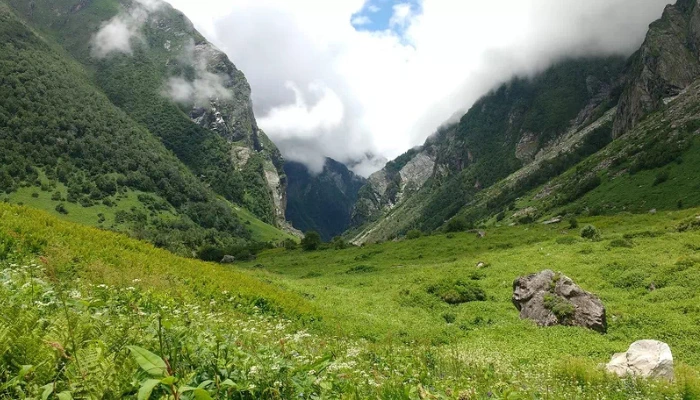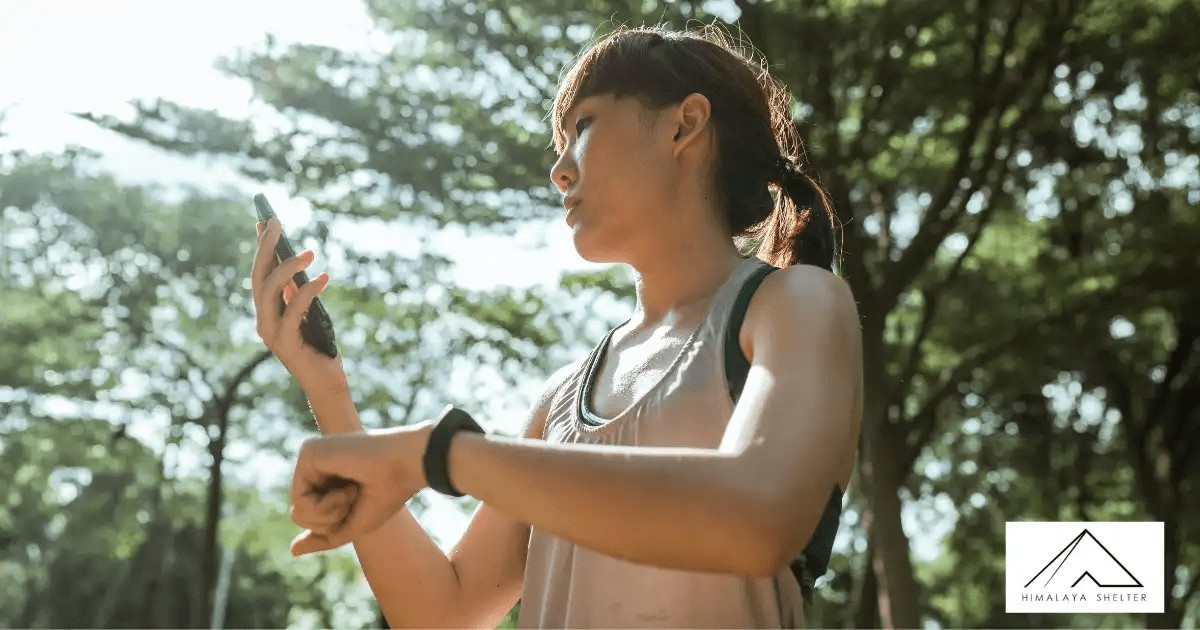
Kalindi Khal Pass Trek
TREK DIFFICULTY
Moderate - Difficult
TREK DURATION
15 Days
HIGHEST ALTITUDE
19,511 Feet
GROUP SIZE
12
TREK DISTANCE
122 Km
BASECAMP
Uttarakhand
BEST TIME
May to June and September
PICKUP POINT
Dehradun (Prince Chowk)
Kalindi Khal Trek Overview:
Kalindi Khal Trek is one the most awe inspiring and rewarding trek options in India. Passing over a high col close to 6,000 m, from camping beside Vasuki Tal, to breathtaking sceneries that include moraines, glaciers and majestic peaks, this tour has it all. Kalindi khal trek adds an interesting flavor to the beauty of Tapovan while exploring undulating alpine meadows, network of gurgling streams and the presence of some of the most renowned Himalayan peaks like Shivling, Bhagirathi and Meru. Combining two sacred Dhams of Gangotri and Badrinath, Kalindi Khal trek offers best of pilgrimage, climbing and elements of nature at its prime.
Kalindi Khal Expedition ( Gangotri to Badrinath Hidden Trail)
Kalindi Khal, also known as Khalindi Pass, stands as a high-altitude mountain pass linking various valleys like Gangotri and Ghastoli (Badrinath) at an elevation of 5942 meters (19495 ft). It ranks as the second-highest pass in the Himalayan Range. The ideal time for this trek or pass crossing is during May-June or September.
This challenging route initially involves a gradual ascent up to Nandan Van, navigating through the Gomukh Glacier and Tapovan. Kalindi Khal Pass offers a panoramic view of the Garhwal Himalayas, spanning from Bhagirathi Valley to Alaknanda Valley. However, it's not recommended for first-time trekkers, suitable only for those with considerable high-altitude trekking experience.
Spanning 86 km, this trek reveals a terrain of moraines and snowfields interspersed with deep crevasses, showcasing high-altitude wildlife and opportunities for camping by small glacial lakes.
For enthusiasts captivated by peaks, the trek unveils stunning views of the Bhagirathi Peaks, Shivling, Meru, and Kedardoom.
Notable destinations along the trek include Dehradun, Rishikesh, Uttarkashi, Gangnani, Gangotri, Gaumukh, Chirbasa, Bhojbasa, Nandanvan, Vashuki Tal, Khara Pather, Rajapara, Arwa Tal, Mana, Badrinath, and Joshimath.
Attractions of Kalindi Khal Trek
As discussed above, Kalindi Khal Trek can be considered one of the most challenging Treks in the Garhwal Himalayas of Uttarakhand. You begin the trek from the Spiritual Abode Gangotri and from Gangotri, the trail following the Kedarganga river will take you to the lush green forests, Spectacular Himalayan meadows, and some lesser-known Himalayan and lesser-explored glaciers of Uttarakhand like Gaumukh Glacier, Kirti Glacier, Sweta (Sita) Glacier. Moreover, you will witness the unmatchable beauty of the Indian Himalayas and if the weather remains clear, you will be able to spot the high mountain peaks like Thelu Peak, Mt. Shivaling Peak (You will also pass through the Shivling Base Camp), Mt. Bhagirath I, II, III; Kalindi Peak and the very famous mountain that has also been described in the ancient Indian scriptures; That is Mt. Meru. If you are looking for an adventurous and thrilling trek that can make you push your physical and mental boundaries, the Kalindi Khal trek is for you. Take your time, Eat healthy, Run daily, Get fit enough, and join us on this thrilling trek of Uttarakhand.

Best Time to Visit the Kalindi Khal Pass Trek
The best time for trekking to Kalindi Khal Pass is from May to June and from September to early October. During this time, weather conditions are favourable for trekking the high-altitude mountain peaks.
- Mid-May to June
During this time, snow on lower altitudes starts melting but on higher altitudes, it is still present. Overall, it’s more settled and avalanche risk is reduced. Landscapes are lush green and fresh. Temperature is relatively moderate: around 5°C to 15°C on lower camps like Gangotri region and around 1°C to 8°C on higher camps near Kalindi Pass. At night it's usually below 0°C. Trekkers must stay updated on the weather forecasts. Sudden rainfall, hailstorms or white out can happen.
- September to early October
Post monsoon, weather is more reliable as rainfall subsides by early September. The sky is clearer and mountain peaks are easily visible. The snow conditions are still good for climbing. Temperature is almost similar to May-June, depending on lower and higher altitudes. By late October, weather conditions can turn cooler and snowfall chances are high so it's advisable to complete the trekking within the October month.
- Months to Avoid
Trekkers should avoid the monsoon season (July-August) due to heavy rainfall. It increases the risk of landslides and makes visibility very poor. Trails become slippery and leech-infested. Similarly, from October to April is also not considered favourable due to cold temperature and heavy snowfall.
Day 1: Drive Dehradun (640 m) to Gangotri (3,048 m) – 241 km, 10–12 hrs.
Day 2: Acclimatization at Gangotri (3,048 m). Visit Gangotri Temple and short hikes.
Day 3: Gangotri to Bhojwasa (3,780 m) – 14 km, 5–6 hrs.
Day 4: Bhojwasa to Tapovan (4,463 m) via Gaumukh – 9 km, 5–6 hrs.
Day 5: Tapovan to Nandanvan (4,340 m) – 7 km, 5–6 hrs.
Day 6: Nandanvan to Vasuki Tal (4,800 m) – 6 km, 5–6 hrs.
Day 7: Vasuki Tal to Khara Patthar (5,130 m) – 7 km, 5–6 hrs.
Day 8: Khara Patthar to Sweta Glacier camp (5,500 m) – 6 km, 5–6 hrs.
Day 9: Sweta Glacier to Kalindi Base (5,600 m) – 6 km, 5–6 hrs.
Day 10: Cross Kalindi Khal Pass (5,950 m) to Rajparav (5,200 m) – 12 km, 10–12 hrs.
Day 11: Rajparav to Arwa Tal (3,910 m) – 13 km, 6–7 hrs.
Day 12: Arwa Tal to Ghastoli (3,798 m) – 16 km, 6–7 hrs.
Day 13: Ghastoli to Mana (3,100 m), drive to Badrinath (3,133 m) – 18 km trek, 6–7 hrs + 3 km drive.
Day 14: Drive Badrinath to Dehradun – 334 km, 12–14 hrs
In Himalaya Shelter, we provide you with the option to customize your trekking experience. Whether you're a solo traveler, a group of friends, or a family, you can opt for our personalized tailor-made trekking program. This customized trek will be exclusively designed for you, taking into account your specific requirements for transportation, accommodation, meals, and any other premium facilities you may need during the trek. No other participants will be added to your group. Choosing a customized trek will enable you to fully enjoy the trek with your loved ones. Click here to learn what a Customized Trekking program looks like.
Kalindi Khal is counted as a revered high-altitude place of Garhwal Himalayas as it connects two sacred pilgrimages- Gangotri and Badrinath. The name 'Kalindi' or 'Khalindi' is based on one of the names of River Yamuna. In ancient text River Yamuna is described as a daughter of Sun God and was called 'Kalindi' also. As per mythology, River Yamuna and Yama (God of Death & Justice) are offsprings of Sun God and Yama for being associated with darkness or black colour (Kaal or Kaala), Yamuna also received the name Kalindi.
Ancient texts describe the Gangotri–Tapovan–Gaumukh region as the sacred birthplace of the River Ganga. It is believed that crossing the Kalindi Khal is not just a geographical journey but also a spiritual passage which takes you from mortality to liberation. Due to the high spiritual frequency, many sages and saints meditated here for years.
In the 20th century, when mountaineers and explorers started surveying the Garhwal Himalayas, modern exploration began and it gained recognition as one of the most challenging high-altitude trekking destinations.
- Gangotri (3,048 m): Gangotri is a small town on the banks of Bhagirathi River (becomes Ganga in Devprayag after meeting with Alaknanda River), named after the Gangotri Glacier, the origin of Ganga River. Here you can visit the famous Gangotri Temple and the scenic beauty of the Himalayas.
- Bhojwasa (3,775 m): Bhojwasa is a beautiful campsite once surrounded by the Bhoj (birch) trees that grew here. You can still find many birch trees here. Here you can view the sunrise and sunset on Bhagirathi massif which looks so mesmerizing and magical.
- Gaumukh (3,890 m): Gaumukh is the snout of the Gangotri Glacier which is shaped like a cow’s mouth and called 'Gau-mukh'. It is counted as one of the most sacred places in the Indian Himalayas.
- Tapovan (4,463 m): Tapovan is an alpine meadow above Gaumukh. Here you can see water streams, wildflowers and surrounding snowcapped peaks. This place is often known as one of the best places for doing Yoga and meditation.
- Nandanvan (4,400 m): Nandanvan is another meadow that lies at the base of Mt Shivling and gives access to Chaturangi Glacier. It is surrounded by the famous peaks like Bhagirathi I, II, III and Kedar Dome.
- Vasuki Tal (4,900 m): Vasuki Tal is a sacred lake named after the Serpent God 'Vasuki'. As per mythology, Lord Vishnu took a sacred bath here. Its crystal-clear water reflects Satopanth and other surrounding peaks.
- Kalindi Khal Pass (5,947 m): Kalindi Khal Pass is the highest and most challenging point of the trek. It lies amid crevassed glaciers and connects Gangotri to Badrinath. From here you can view Shivling, Meru, Bhagirathi peaks, Chandra Parvat and Satopanth.
- Mana Village (3,200 m): Mana Village is known as the last Indian village before Tibet. Locals often associated it with Pandavas from Mahabharata. Visitors can see the Bheem Pul, a natural stone bridge here.
- Badrinath (3,300 m): Khalindi Pass trek ends in the Badrinath, one of the holiest Char Dham shrines. Badrinath is dedicated to Lord Vishnu. Pilgrims often take baths here in the Tapt Kund hot spring and visit Badrinath Temple.
The Kalindi Khal Pass is considered one of the most difficult and challenging treks in the Indian Himalayas. It is located at the altitude of around 5,950 m (19,520 ft) above sea level. It is ideal for seasoned trekkers who are looking for a thrilling journey, spiritual depth and high-altitude adventure.
The terrain of Kalindi Khal Pass is highly diverse. It ranges from dense forests to lush meadows, steep ascents, glaciers, moraines and crevassed ice fields. Every day, trekkers have to walk through transforming landscapes which is adventurous but also challenging.
The total trek duration is around 12 to 15 (including travel) days which covers approx 90 km, depending on the route. Each day involves at least 6 hours of walking which can stretch to 10 to 12 hours. The route involves crossing major glaciers such as the Gangotri, Chaturangi and Sweta where the landscape is often barren, icy and hostile.
Weather conditions can be unpredictable at higher altitudes. Nights can be freezing cold. Snowfields may remain even during the peak summer. Sudden rainfall and hailstorm can add delays and difficulties.
Trekkers need basic technical support while crossing the pass. On snowfields and steepy ridges, usage of rope and ice axes are common. The basic mountaineering skills and technical guidance is required. There are no proper infrastructure and emergency services en route; a well-equipped support team is essential.
Due to high-altitude and technical challenges, Kalindi Khal Pass trek is not suitable for kids and families. Beginners can attempt it but they must be physically fit and mentally enduring. Proper guidance and acclimatization are very important. Solo trekking is also not advisable due to remote terrain, safety and navigation.
The journey for Kalindi Khal Pass usually starts from Gangotri, a well-known pilgrimage town in Uttarakhand that is easily accessible by road from Dehradun, Rishikesh or Haridwar.
From Delhi, one can first reach Dehradun by train, flight or bus, and then take a taxi to Gangotri via Uttarkashi. Gangotri is the starting point of the trek. From here, the trekking begins towards Bhojwasa, an open meadow, following the path along the Bhagirathi River.
The next stretch goes towards Gaumukh, the snout of the Gangotri Glacier and then gradually climbs up to Tapovan, a famous campsite at the base of Mount Shivling. After Tapovan, trekkers move towards Nandanvan, crossing rocky moraine paths and glacier sections. The trail then proceeds to Vasuki Tal- a high-altitude lake, before proceeding to Khara Pathar and Sweta Glacier.
The most difficult section is the steep climb to Kalindi Khal Pass at an elevation of about 5,950 m. Here usage of technical gear and guidance are often required. From the pass, the trail descends towards Arwa Valley, passing through campsites like Kalindi Base and Raj Parav. The trek finally ends at Ghastoli and then reaches the road-head at Mana village, which is close to Badrinath.
From Mana, vehicles are available to reach Badrinath and further to Haridwar, Rishikesh or Dehradun. In short, to reach Kalindi Khal, one has to travel to Gangotri by road, complete the long high-altitude trek across glaciers and exit at Mana near Badrinath.

How to Reach Kalindi Khal
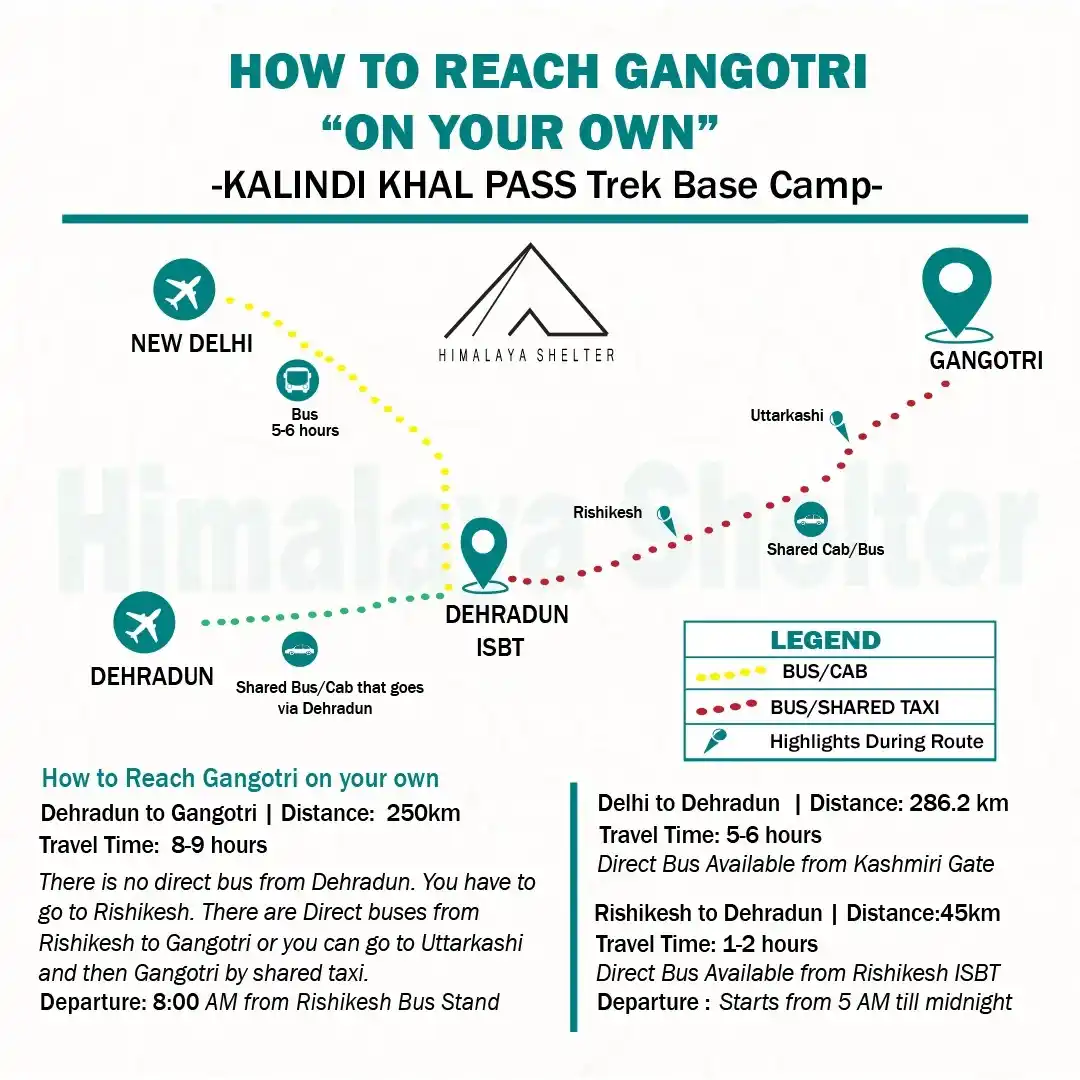
How to reach Kalindi Khal "On Your Own"
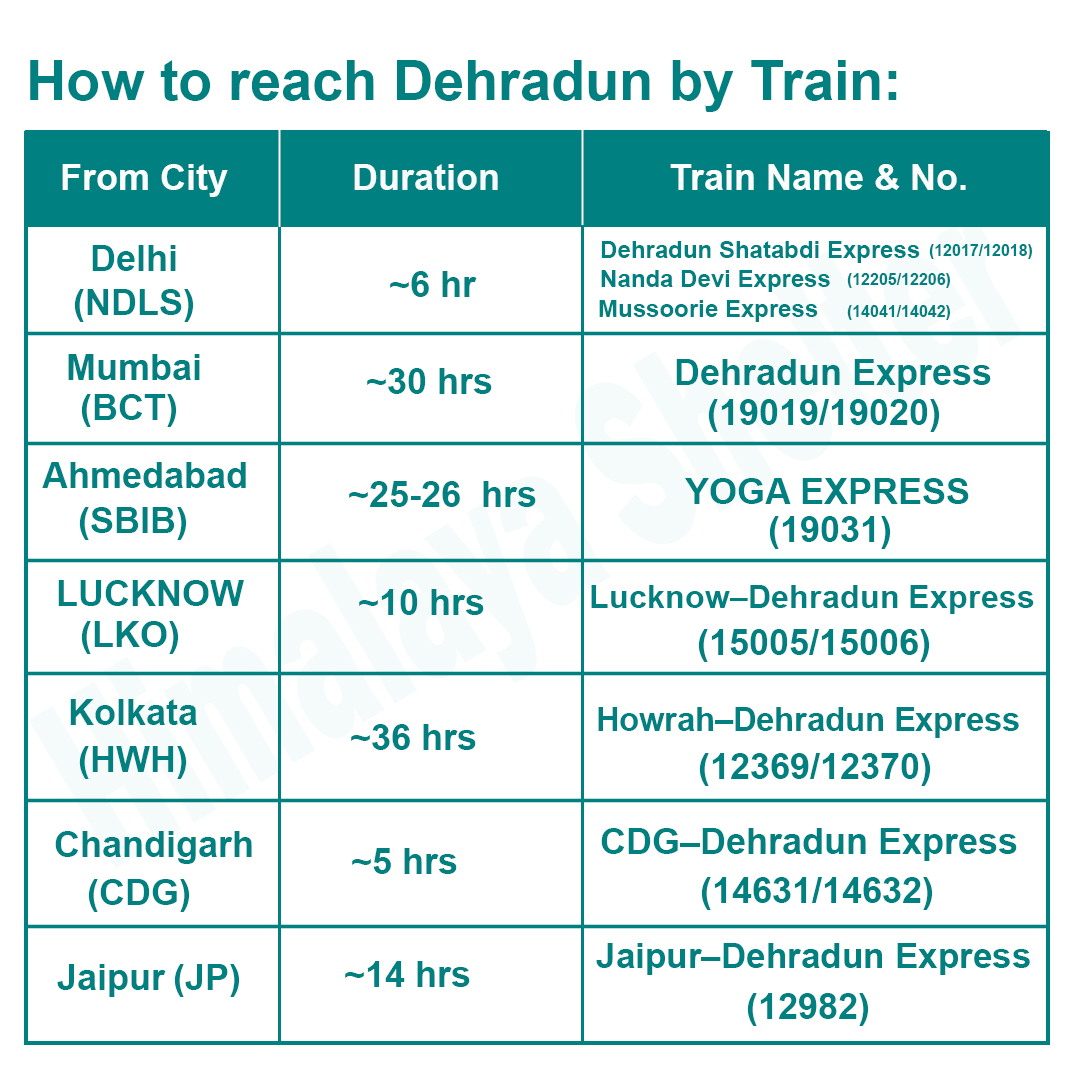
How to reach Dehradun by Train
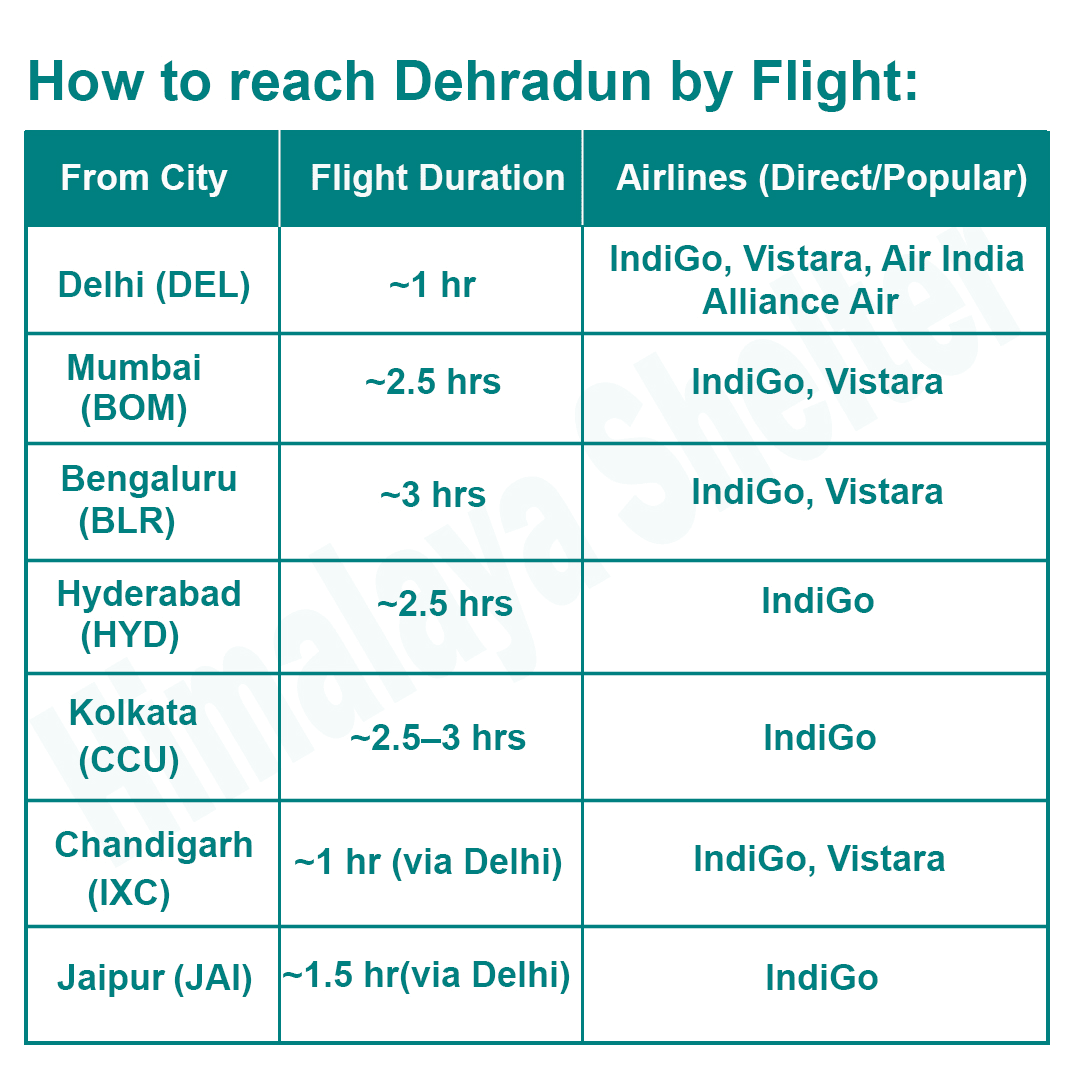
How to reach Dehradun by Flight
Clothing
- 2-3 quick-dry T-shirts (full sleeves preferred)
- 2 trek pants (water-resistant if possible)
- 1-2 fleece jacket or woollen sweater
- 1 down jacket or heavy padded jacket
- 1-2 thermal inner set (top + bottom)
- Waterproof & windproof jacket
- Poncho or raincoat
- Woolen cap + Sun cap
- Neck gaiter or scarf
- 2–3 pairs of synthetic/woolen socks + 1 pair of woolen gloves
- Innerwear (quick-dry), towel
Footwear
- Trekking shoes (ankle-high, good grip)
- Floaters/sandals (for campsites)
- Gaiters (recommended due to snow/rock)
Trekking Gear
- 50–60L backpack with rain cover
- 20–30L daypack (for summit day & side hikes)
- Trekking poles (highly recommended)
- Headlamp with spare batteries
- Sleeping bag (–10°C to –20°C comfort rating, if not provided)
- Dry bags or ziplocks (to keep items dry)
Toiletries & Hygiene
- Toothbrush, toothpaste, biodegradable soap
- UV-protection sunglasses
- Sunscreen (SPF 50+), lip balm (SPF)
- Wet wipes, hand sanitizer
- Toilet paper, sanitary pads/tampons (carry back used items)
- Small quick-dry towel
Personal Medical Kit
- Diamox (for altitude)
- Crocin/Dolo, Combiflam, Digene
- ORS sachets, antiseptic cream
- Band-aids, gauze, crepe bandage
- Personal meds (if any)
- Betadine/Savlon
Documents
- Valid ID proof (Aadhaar, Voter ID, etc.)
- Medical certificate (fitness)
- Disclaimer form (from your trek operator)
Others
- Power bank
- Extra camera batteries (cold drains battery fast)
- Energy bars, dry fruits, glucose
- Notebook + pen (optional for journaling)
- Some cash (no ATM in region)
Technical Gear (usually arranged by trek organizers, but confirm)
- Crampons/microspikes
- Ice axe
- Climbing helmet
- Harness, carabiners, ropes
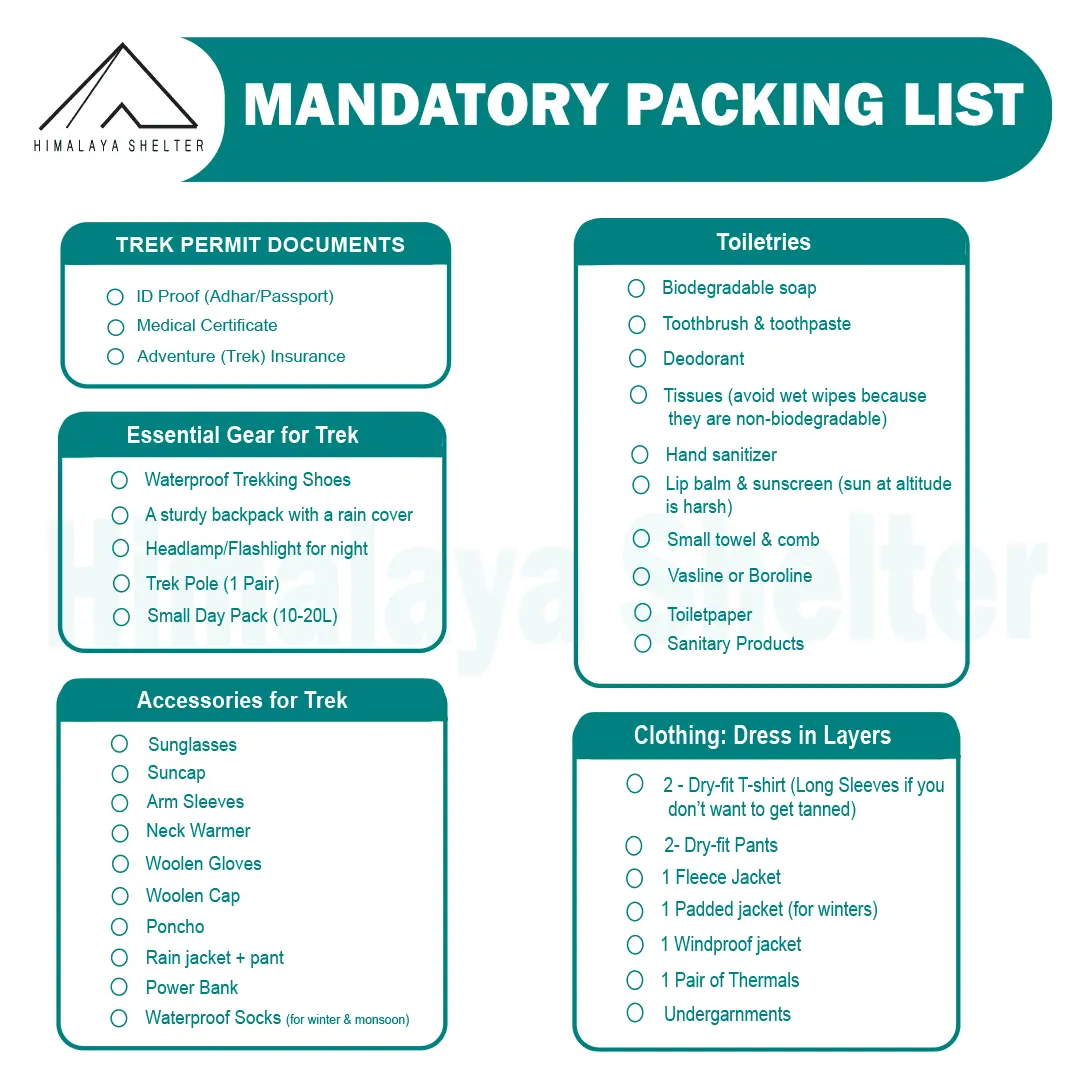
Mandatory Backpacking List for Kalindi Khal Pass Trek
Physical Fitness Preparation for Trek:
To overcome the difficulty level of Bali pass trekking, it requires strong cardiovascular endurance, muscular strength, and overall physical fitness. Incorporate these exercises into your routine to increase strength, stability, and stamina, which will help you tackle difficult terrain sections of the trail at high altitudes.
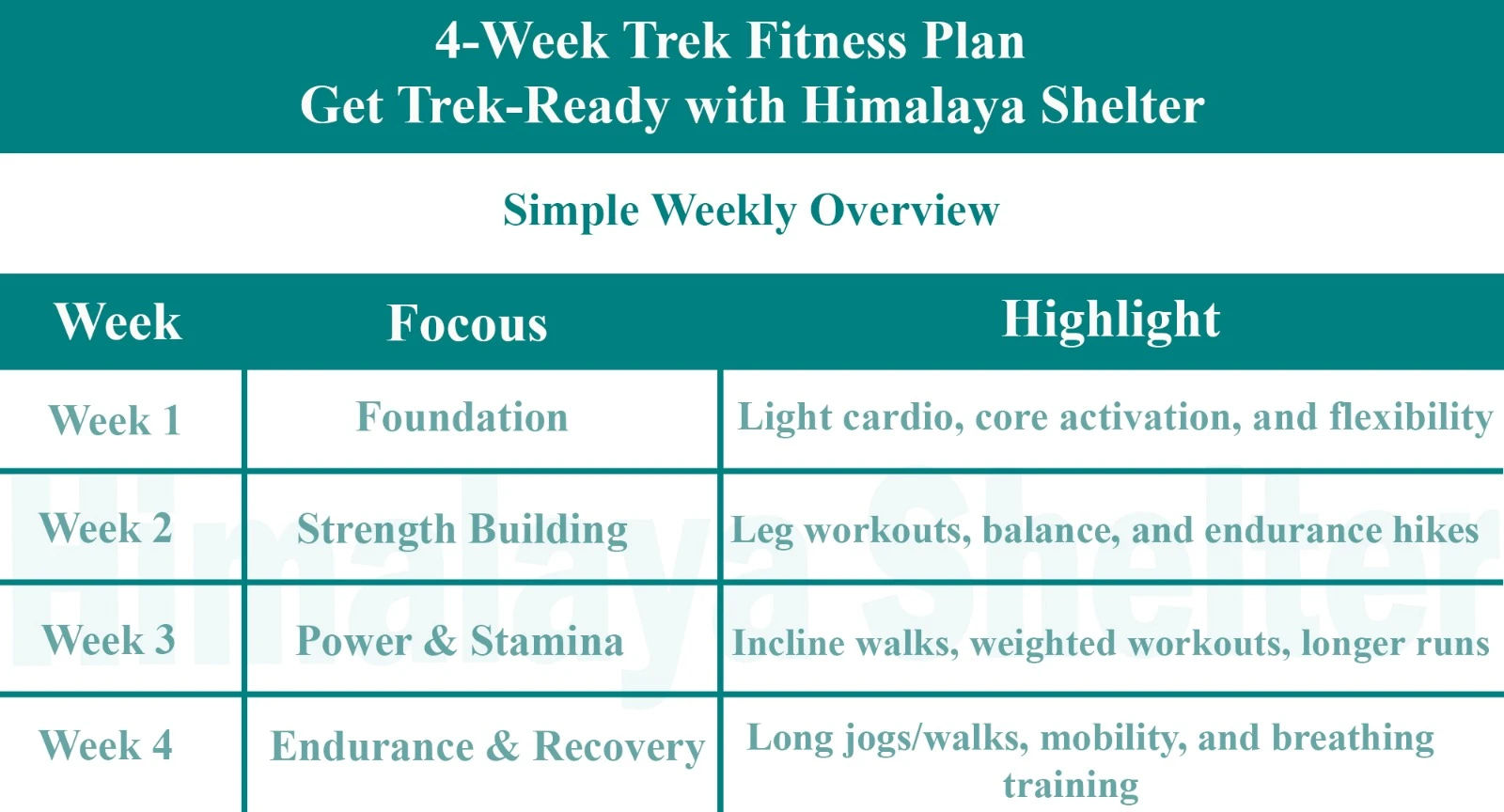
Overview

Foundation
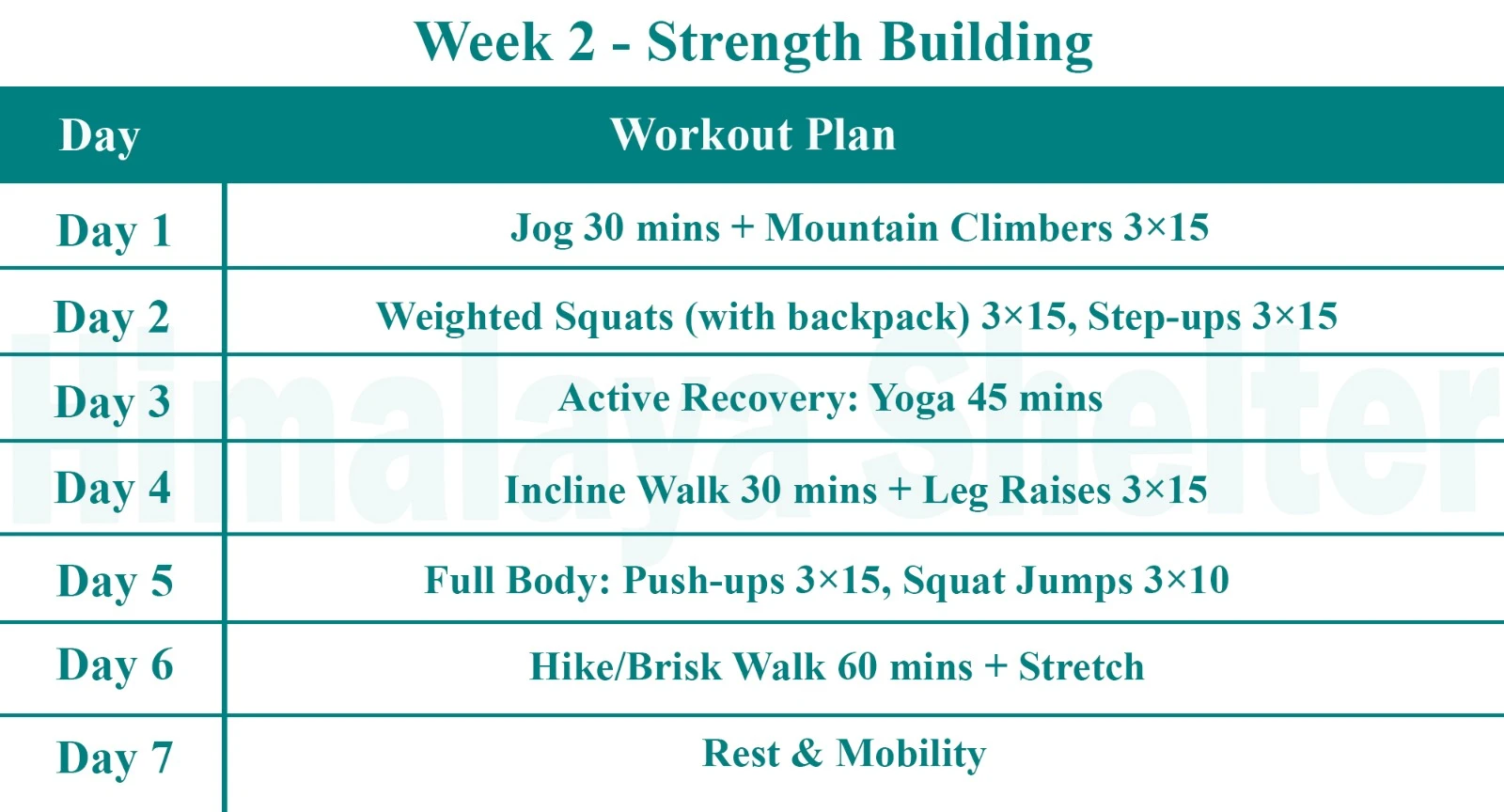
Strength Building
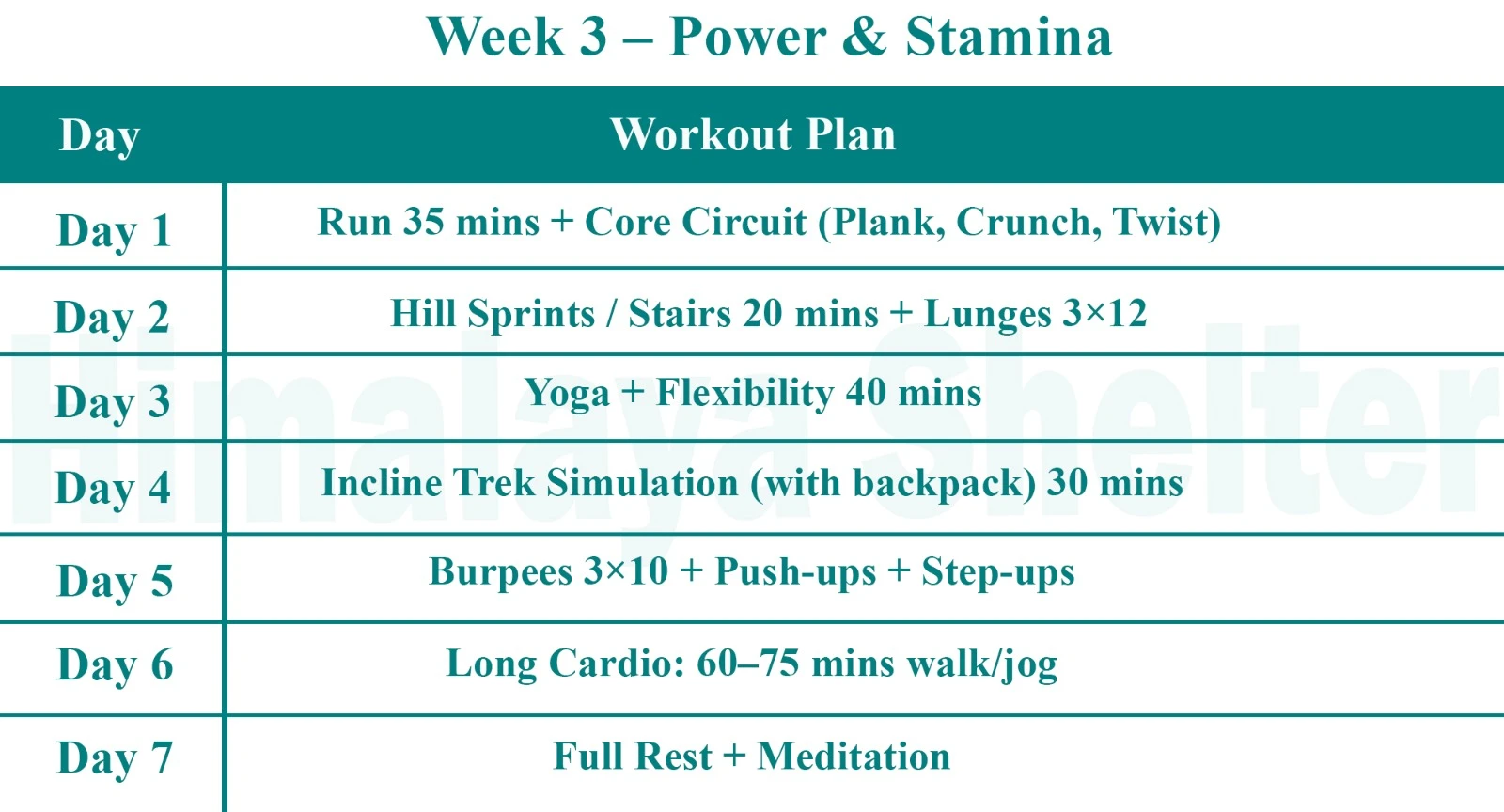
Power & Stamina
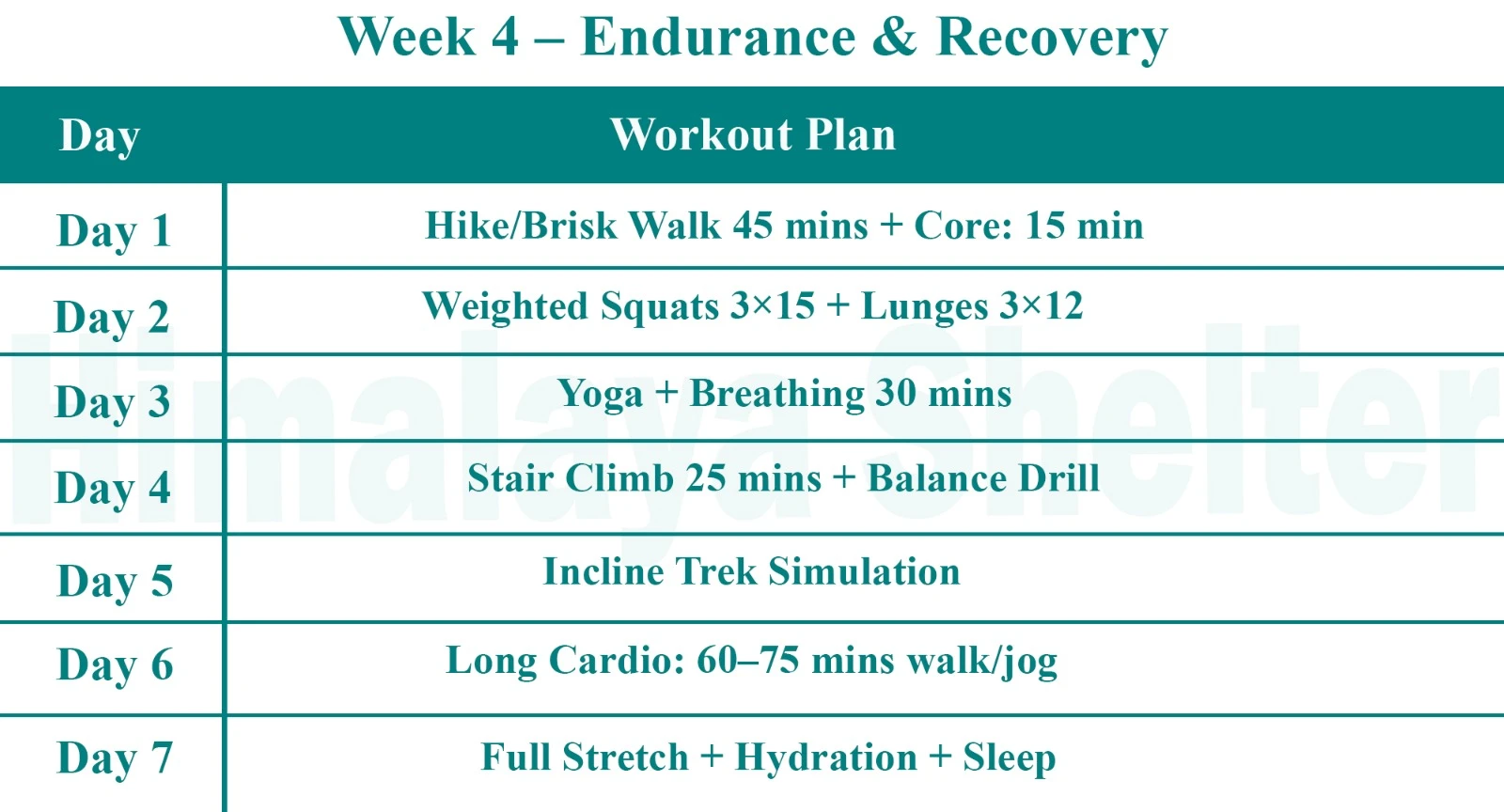
Endurance & Recovery
Day 1: Dehradun to Gangnani
Altitude: 2,100 ft (640 m) – 6,430 ft (1,960 m)
Accommodation: Guest House / Homestay / Hotel
Meals: Dinner
Day 2: Gangnani to Gangotri
Drive: 52 km, 2 hrs
Altitude: 6,430 ft (1,960 m) – 10,000 ft (3048 m)
Accommodation: Guest House / Homestay / Hotel
Meals: Breakfast + Lunch + Evening Snacks + Dinner
Day 3: Gangotri to Bhojwasa
Trek: 14 km, 6-7 hrs
Altitude: 10,000 ft (3048 m) – 12,467 ft (3,800 m)
Accommodation: Camping (Alpine Tents)
Meals: Breakfast + Lunch + Evening Snacks + Dinner
Day 4: Bhojbasa to Gaumukh to Tapovan
Trek: 13 km, 6-7 hrs
Altitude: 12,467 ft (3,800 m) – 12,795 ft (3,900 m) – 14,640 ft (4,462 m)
Accommodation: Camping (Alpine Tents)
Meals: Breakfast + Lunch + Evening Snacks + Dinner
Day 5: Tapovan rest day
Trek: NA
Altitude: 14,640 ft (4,462 m)
Accommodation: Camping (Alpine Tents)
Meals: Breakfast + Lunch + Evening Snacks + Dinner
This day is free for us to acclimatize, relax and enjoy the magnificent snow-capped peaks, flora, fauna, and mountain landscape. This land is frequented by some of the greatest contemporary mountaineers. The Shivling peak stands tall in front of us. Behind Shivling, towards the right is Meru. A little towards the left of Shivling, is Sumeru. The Bhagirathi peaks are visible further to the left. Bhagirathi III, Meru (Central Peak) and Sumeru have some of the hardest climbing routes in the world. We can visit the Meru Glacier and return to our campsite.
Day 6: Tapovan to Nandanvan
Trek: 8 km, 6 hrs
Altitude: 14,640 ft (4,462 m) – 15,780 ft (4,810 m)
Accommodation: Camping (Alpine Tents)
Meals: Breakfast + Lunch + Evening Snacks + Dinner
On this day, post-breakfast, our trek begins with a descent onto the glacier. The glacier, nestled between two ranges, often features a layer of rocky moraine due to landslides, facilitating somewhat easier walking conditions. However, staying together as a group is crucial on the glacier, as veering off the trail is common. Keeping a watchful eye on cairns, or stacked rocks, helps maintain the right path.
Walking on the glacier demands caution due to its slippery surface. Even a momentary lapse in focus can pose risks, given the presence of large crevasses scattered throughout. After covering about a kilometer, the trail ascends vertically, navigating through substantial boulders alongside. Dinner and overnight camping await us at the Nandanvan campsite.
Day 7: Nandanvan to Vasuki Tal
Trek: 6 km, 4-5 hrs
Altitude: 15,780 ft (4,810 m) – 15,748 ft ft (4,800 m)
Accommodation: Camping (Alpine Tents)
Meals: Breakfast + Lunch + Evening Snacks + Dinner
Day 8: Vasuki Tal to Khara Pathar
Trek: 6 km, 5-6 hrs
Altitude: 15,748 ft ft (4,800 m) – 17,060 ft (5,200 m)
Accommodation: Camping (Alpine Tents)
Meals: Breakfast + Lunch + Evening Snacks + Dinner
Day 9: Khara Pathar to Sweta Glacier
Trek: 8 km, 5-6 hrs
Altitude: 17,060 ft (5,200 m) – 17,880 ft (5,500 m)
Accommodation: Camping (Alpine Tents)
Meals: Breakfast + Lunch + Evening Snacks + Dinner
After breakfast, our trek continues towards Sweta Glacier, reaching an altitude of 5,500 meters. This leg of the journey is relatively shorter in duration, leading us to a campsite nestled in the moraine, characterized by an expanse filled with rocks and boulders.
Day 10: Sweta Glacier to Kalindikhal Base Camp
Trek: 6 km, 4-5 hrs
Altitude: 17,880 ft (5,500 m) – 18,372 ft (5,600 m)
Accommodation: Camping (Alpine Tents)
Meals: Breakfast + Lunch + Evening Snacks + Dinner
Day 11: Kalindikhal Base Camp to Raj Parav via Kalindi Khal
Trek: 13 km, 8-9 hrs
Altitude: 18,372 ft (5,600 m) – 19,500 ft (4,945 m) – 16,076 ft (4,900 m)
Accommodation: Camping (Alpine Tents)
Meals: Breakfast + Lunch + Evening Snacks + Dinner
On this day, our trek spans a distance of 12 kilometers towards Kalindi Pass, standing at an elevation of 5947 meters. Upon reaching this breathtaking spot, we’ll indulge in some time to absorb the beauty before descending to camp at Rajparav.
The ascent to the pass is undoubtedly challenging, demanding a consistent and steady pace until we reach our destination. However, the moment you stand atop the pass, the realization dawns that every ounce of effort was truly worthwhile. The panoramic vistas of Mt. Kamet, Mt. Mana, Chandra Parbat, Vasuki Parbat, and, on clear days, even glimpses of the Tibetan Plateau, unfold before you, offering an awe-inspiring reward for your toil and determination.
Day 12: Raj Parav to Arwatal
Trek: 13 km, 6-7 hrs
Altitude: 16,076 ft (4,900 m) – 12,830 ft (3,910 m)
Accommodation: Camping (Alpine Tents)
Meals: Breakfast + Lunch + Evening Snacks + Dinner
We commence the trek early in the morning, heading towards Arwatal at an altitude of 3,910 meters. The journey encompasses a lengthy traverse across glacier terrain, ultimately leading us to the stunning Arwa Tal.
Day 13: Arwatal to Ghastoli
Trek: 7 km, 4-5 hrs
Altitude: 12,830 ft (3,910 m) – 12,435 ft (3,790 m)
Accommodation: Camping (Alpine Tents)
Meals: Breakfast + Lunch + Evening Snacks + Dinner
We set out early for a 16-kilometer trek to Ghastoli (3796 m), departing from Arwatal. The journey entails a considerable walk across moraines, showcasing a striking transition in the terrain from stark grey to lush greenery as we approach Ghastoli. This location is a breathtaking meadow, a visual delight, offering a serene and picturesque respite along the trek.
Day 14: Ghastoli to Mana to Badrinath
Trek: 6 km, 3 hrs
Drive: 10 km, 30 min
Altitude: 12,435 ft (3,790 m) – 10,500 ft (3,200 m) – 10,826 ft (3,300 m)
Accommodation: Camping (Alpine Tents)
Meals: Breakfast + Lunch + Evening Snacks + Dinner
Day 15: Badrinath to Dehradun
Drive: 327 km, 8-9 hrs
Altitude: 10,826 ft (3,300 m) – 2,100 ft (640 m)
Accommodation: Camping (Alpine Tents)
Meals: Breakfast + Lunch + Evening Snacks + Dinner
After breakfast, we’ll embark on a drive to Dehradun. The journey traces along the Alaknanda River until we reach Devprayag, where it merges with the Ganges.
Our treks are specially designed by the experienced team at Himalaya Shelter, taking you on an adventure of a lifetime all while making you connect not only with the bountiful nature but also with yourself and with others on the trek with you creating wonderful memories which will last you a lifetime. All Himalaya Shelter treks are guided by experienced Trekkers having vast knowledge and experience of the region, providing with insightful information and stories pertaining to the region’s flora and fauna and the history of the region whilst the trek. It is safe to say that on successfully completing the trek, one will gain tremendous insight and experience along with lifetime memories.
Inclusion
- Transport support from Dehradun to Dehradun (Pick-up location: Prince Chowk, near Dehradun Railway Station, Pick-up Time: Around 7:30 am).
- Accommodation – At Base Camp, stay at a local homestay or guest house for one night each, which will give you an insight into the authentic lifestyle of the locals. (INR 5000 per person extra for single sharing throughout the trek )
On Trek stay in a 2-person Vango Halo Pro/A-Shape tent, which is to be shared by two trekkers, built to withstand extreme weather conditions and at the same time making you comfortable after a hard day’s trek. - Camping Equipment – specially designed sleeping bags that can withstand harsh weather conditions, foam mattresses. Other safety gear like microspikes, gaiters, an ice axe, and helmets will be provided.
- Medical Kit – our team will be equipped with an extensive medical kit, which our team is trained and experienced to use. Oxygen cylinders are used after they are thoroughly inspected throughout the Trek. Even campsites have large oxygen cylinders as backups.
- Permission - Forest entry charges for Indian nationals (Additional charges will be applicable for international tourists)
- Meals – Breakfast, packed lunch (on trek days), evening snacks, and dinner will be served. A hearty, delicious, and nutrition-filled Veg meals with egg preparation will be provided throughout the trek. (Jain and Vegan Food can also be arranged on prior notification.)There will be a dedicated Kitchen Tent along with a dining tent, which will have a dining table too.
- Our Team – A highly experienced and AMC-certified Trek Leader who will help ensure that the entire trek goes smoothly and safely while navigating the challenging conditions during the trek, and is skilled enough to navigate any medical emergency that can arise during the trek. Local and route Guides who are well-versed with the region and provide an in-depth insight into the local customs and knowledge of the flora and fauna endemic to the region. A dedicated Kitchen staff, which includes a Cook, a helper, and other support staff. There will also be porters and mules to carry common equipment.
- Cloakroom - We have a cloakroom facility available for extra luggage. Every trekker is permitted to leave their luggage behind at no charge.
Exclusions
- Personal expenses like tips, personal medicines, phone calls etc.
- Travel Expenses - Travel expenses from your hometown to the mentioned Pick-Up Point are not included in the trek fee.
From the scheduled pick-up spot to the base camp, we have our own fleet of vehicles like Bolero, Innova, Dezire, or Tempo Traveler (12-seater). This is be shared by trekkers for a pre-decided amount. All vehicles are non-AC. - Personal Equipment - Any personal gear like jackets, shoes, cutlery, or backpacks are not included in the trek fee. We recommend renting them from our Rental Store for an affordable fee. This can be pre-arranged to avoid last-minute hang-ups.
- Offloading - We encourage carrying your backpack to get into the true spirit of trekking. However, if needed, you can opt to offload your personal luggage of up to 12 kgs for an additional cost of INR 500 per bag per day.
- Trek Insurance - A mandatory trek insurance fee is charged in addition to your trek fee. Since most medical insurance doesn’t cover adventure activities, trek insurance offers essential coverage, enhancing your safety without a significant financial burden.
- Buffer day on the trek - We have kept a buffer day on the trek to account for any weather-related delay. If this is utilized, you will need to pay an extra amount to your trek leader.
- Anything apart from inclusions
- Please carry a lunch box for a packed lunch/breakfast to avoid using polythene and Aluminium foil.
Keeping the Himalayas clean is our own responsibility. Reduce the use of Plastic when you are in the abode of the Sacred Himalaya. 🌱
Read More on Kalindi Khal Pass Trek
Photo Gallery




Treks by Categories
Treks By Month

Treks By Experience








